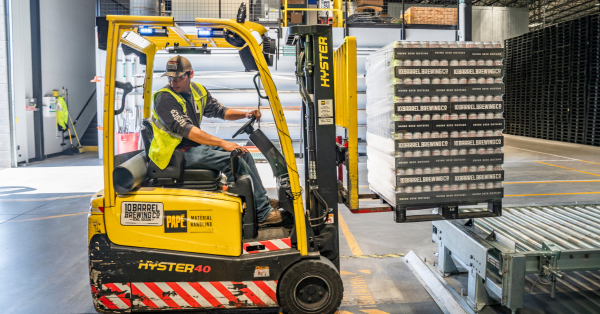Warehouse Location Strategy: Finding the Right Fit
.png?width=600&height=314&name=Ship%20my%20Orders%20Blog%20%2329%20(2).png)
Every choice you make is important when it comes to managing a profitable business. One decision that can have a significant impact on the overall efficiency and profitability of a company is the selection of warehouse locations. The strategic placement of warehouses plays a crucial role in supporting a business's logistics and supply chain operations.
We will explore the importance of warehouse location selection and how third-party logistics providers (3PLs) can assist businesses by handling inventory management and shipping.
The Importance of Warehouse Location
The location of a warehouse is a critical factor that can significantly influence a company's operations. The right warehouse location can lead to improved customer service, reduced transportation costs, faster order fulfillment, and enhanced overall supply chain efficiency. On the other hand, a poorly chosen warehouse location can result in increased transportation expenses, longer lead times, and dissatisfied customers.
Here are some of the key factors that businesses need to consider when selecting warehouse locations:
Proximity to Suppliers and Customers
One of the primary factors to consider when choosing a warehouse location is its proximity to suppliers and customers. If a business relies heavily on timely and frequent deliveries from suppliers, locating a warehouse near the suppliers can help minimize transportation costs and reduce lead times. Similarly, placing warehouses in close proximity to customers can enable faster order fulfillment and improve customer satisfaction.
Transportation Infrastructure
The availability and quality of transportation infrastructure in the vicinity of a warehouse location are crucial considerations. Warehouses should be easily accessible to major highways, airports, and ports to ensure efficient inbound and outbound logistics. A well-connected transportation network can expedite the movement of goods and reduce transportation costs.
Labor Availability
The availability of a skilled labor force is another crucial factor to consider when selecting warehouse locations. Businesses must assess the local labor market's availability and determine whether there is an adequate supply of workers with the necessary skills and experience to support warehouse operations. Proximity to educational institutions and training centers can also be advantageous in attracting and retaining competent staff.
Cost of Real Estate
The location has a major impact on real estate prices. It is essential to evaluate the expense of acquiring or leasing properties in different areas when deciding on a warehouse location. While it may be tempting to opt for cheaper locations, businesses must also consider the impact of transportation costs and access to labor markets. Striking the right balance between real estate costs and other factors is critical to achieving long-term cost efficiency.
Regulatory and Tax Considerations
Regulatory compliance and tax implications can vary from one location to another. Before finalizing a warehouse location, businesses need to assess the local regulations related to labor, environment, zoning, and permits. Additionally, studying the tax implications, such as property tax rates and incentives offered by certain jurisdictions, can influence the decision-making process.
Market Expansion Opportunities
When selecting warehouse locations, businesses should also consider the potential for market expansion. Identifying regions with growing markets and positioning warehouses strategically can facilitate future business growth and allow companies to respond quickly to changing customer demands. The ability to scale operations in response to market expansion can be a significant advantage.
Now that we have explored the key factors to consider when selecting warehouse locations, let's delve into how third-party logistics providers (3PLs) can assist businesses in determining optimal warehouse placement.
How 3PLs Assist Businesses in Determining Optimal Warehouse Placement
Third-party logistics providers (3PLs) offer specialized expertise in supply chain management and logistics. They can efficiently assist businesses in having the optimal warehouse placement based on their unique requirements.
Here are a few ways in which 3PLs identifies the optimum warehouse location:
Network Design and Optimization
3PLs have the knowledge and tools to evaluate various factors, such as customer locations, demand patterns, transportation costs, and inventory requirements. They can conduct comprehensive network design and optimization analyses to identify the most efficient warehouse locations for businesses. By leveraging advanced algorithms and modeling techniques, 3PLs can develop data-driven recommendations that consider both current and future supply chain needs.
Data Analytics and Market Insights
3PLs possess robust data analytics capabilities that can provide businesses with valuable market insights. They can analyze historical data, market trends, and customer behavior patterns to identify potential growth opportunities and optimize warehouse placement accordingly. 3PLs help businesses make informed decisions backed by data, ensuring that warehouse locations align with market demands.
Cost Efficiency and Risk Mitigation
By partnering with 3PLs, businesses can achieve cost efficiency and risk mitigation in warehouse placement. 3PLs have extensive knowledge of different markets and can help identify cost-effective warehouse locations that strike the right balance between real estate expenses, transportation costs, and labor availability. Moreover, 3PLs can assess and mitigate potential risks associated with warehouse location decisions, such as natural disasters and geopolitical factors.
Flexibility and Scalability
As businesses grow and evolve, their warehouse requirements may change. 3PLs offer flexibility and scalability by providing access to a network of warehouses and distribution centers. Through their vast network, 3PLs can help businesses expand into new markets, establish regional fulfillment centers, and adapt warehouse locations to meet changing customer demands. The ability to scale operations without significant capital investments is a key advantage offered by 3PLs.
Improved Customer Service and Operational Efficiency
Optimal warehouse placement directly impacts customer service and operational efficiency. By strategically locating warehouses, businesses can ensure faster order fulfillment, reduced shipping times, and improved inventory management. 3PLs work closely with businesses to understand their customer service goals and align warehouse placement to enhance customer satisfaction. They help businesses achieve operational excellence by streamlining and optimizing warehouse processes.
Takeaways
In conclusion, selecting the right warehouse locations is crucial for businesses aiming to optimize their logistics and supply chain operations. Factors such as proximity to suppliers and customers, transportation infrastructure, labor availability, and cost of real estate must be carefully evaluated.
3PL services like Ship My Orders provides businesses with the gift of time by handling the overall inventory management and shipping, allowing clients to focus on product development, customer service, and sales. Contact Us to Elevate Your Supply Chain Game.

-1.png)


